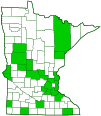black-sided meadow katydid
(Conocephalus nigropleurum)
Conservation • Description • Habitat • Ecology • Distribution • Taxonomy
Conservation Status |
|
|||||||
| IUCN Red List | not listed |
|||||||
| NatureServe | NNR - Unranked |
|||||||
| Minnesota | not listed |
|||||||
Description |
||
Black-sided meadow katydid is a small, easily recognized, lesser meadow katydid. It occurs in northern United States from Vermont to South Dakota south to Ohio and Kansas, and in Quebec and Ontario, Canada. It is found in wet marshy areas. Adults are slender and less than 1″ long. Their striking coloration is unique among North American katydids. The top of the head (vertex) is yellowish-brown with a black longitudinal line in the middle. The face and the sides of the head below the compound eyes (genae) are dark brown. The eyes are black and somewhat protruding. The antennae are slender and long, much longer than the body. There is a rounded projection between the antennae bases that does not project beyond the first antennal segment. The exoskeletal plate covering the thorax (pronotum) is mostly dark brown. The margins of each side (lateral lobe) of the pronotum are bright green. There are two small spines on the underside of the thorax. The abdomen is shiny black. Occasionally it is black on the sides and very dark brown above, especially on females. On the male, the sensory appendages (cerci) at the end of the abdomen are bright green. On the female, the egg-laying appendage (ovipositor) is blade-like, sharply pointed, slender, straight, and long, about as long as the abdomen. The forewings (tegmina) are leathery, bright green, translucent and short. They do not extend to the end of the abdomen. The legs are bright green. The greatly enlarged third segment (femur) of the hind leg has one or more spines on the underside. The fourth segment (tibia) of the hind leg has three pairs of spurs. The last part of the leg (tarsus), corresponding to the foot, has four segments. |
||
Song |
||
Size |
||
Total length: Less than 1″ |
||
Similar Species |
||
Habitat |
||
Wet meadows, marshy areas |
||
Ecology |
||
Season |
||
|
||
Behavior |
||
|
||
Life Cycle |
||
|
||
Nymph Food |
||
Plant juices |
||
Adult Food |
||
|
||
Distribution |
||||
|
Sources |
|||
| 8/2/2022 | ||||
Occurrence |
||||
|
||||
Taxonomy |
|||
Order |
Orthoptera (grasshoppers, crickets, and katydids) | ||
Suborder |
Ensifera (katydids, crickets, and allies) | ||
| Infraorder | Tettigoniidea (katydids, wētā, and allies) | ||
Superfamily |
Tettigonioidea | ||
Family |
Tettigoniidae (katydids) | ||
Subfamily |
Conocephalinae (coneheads and meadow katydids) | ||
Tribe |
Conocephalini (common meadow katydids) | ||
Genus |
Conocephalus (lesser meadow katydids) | ||
| Subgenus | Conocephalus | ||
Synonyms |
|||
Conocephalus nigropleuroides |
|||
Common Names |
|||
black-sided meadow katydid |
|||
Glossary
Cercus
One of a pair of small sensory appendages at the end of the abdomen of many insects and other arthropods. In Odonata, one of the upper claspers. Plural: cerci.
Femur
On insects and arachnids, the third, largest, most robust segment of the leg, coming immediately before the tibia. On humans, the thigh bone.
Gena
In insects: The area between the compound eye and the mandible; the cheek. In birds: The area between the the angle of the jaw and the bill; the feathered side (outside) of the under mandible. Plural: genae.
Ovipositor
A tube-like organ near the end of the abdomen of many female insects, used to prepare a place for an egg and to place the egg.
Tarsus
On insects, the last two to five subdivisions of the leg, attached to the tibia; the foot. On spiders, the last segment of the leg. Plural: tarsi.
Tegmen
The modified, leathery front wing of grasshoppers and related insects that protects the hindwing. It may also serve as a camouflage, a defensive display, or a sound board. Plural: tegmina.
Tibia
The fourth segment of an insect leg, after the femur and before the tarsus (foot). The fifth segment of a spider leg or palp. Plural: tibiae.
Visitor Photos |
|||||
Share your photo of this insect. |
|||||
| This button not working for you? Simply email us at info@MinnesotaSeasons.com. Attach one or more photos and, if you like, a caption. |
|||||
Lucy Morrissey |
|||||
on the underside of a milkweed leaf |
|||||
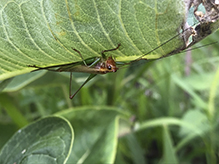 |
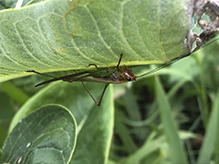 |
||||
Matthaak |
|||||
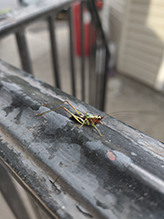 |
|||||
Alfredo Colon |
|||||
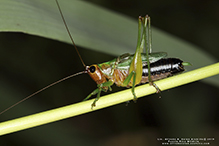 |
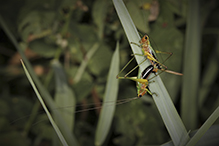 |
||||
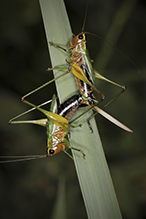 |
|||||
MinnesotaSeasons.com Photos |
|||||
|
|||||

Slideshows |
||

Visitor Videos |
|||
Share your video of this mammal. |
|||
| This button not working for you? Simply email us at info@MinnesotaSeasons.com. Attach a video, a YouTube link, or a cloud storage link. |
|||
Other Videos |
|||
| Black-sided Meadow Katydid (Tettigoniidae: Conocephalus nigropleurum) Nymph on Post Carl Barrentine |
|||
About
Jul 23, 2009 Photographed at the Kellys Slough NWR, North Dakota (23 July 2009). Thank you to David Ferguson(@Bugguide.net) for helping me to identify this specimen. |
|||
| Black-sided Meadow Katydid (Tettigoniidae: Conocephalus nigropleurum) on Blossom Carl Barrentine |
|||
About
Aug 19, 2010 Photographed at the Kellys Slough NWR, North Dakota (19 August 2010). |
|||
| Black-sided Meadow Katydid (Tettigoniidae: Conocephalus nigropleurum) Eating Carl Barrentine |
|||
About
Sep 5, 2010 Photographed at Kellys Slough NWR, North Dakota (05 September 2010). Go here to view other images of this species: http://bugguide.net/node/view/25883 |
|||
| Black-sided Meadow Katydid (Tettigoniidae: Conocephalus nigropleurum) Female on Blossom Carl Barrentine |
|||
About
Sep 8, 2009 Photographed at Grand Forks, North Dakota (07 September 2009). Thank you to David Ferguson(@Bugguide.net) for helping me to identify this species. |
|||


Created: 2/8/2020
Last Updated:
